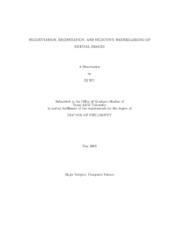| dc.description.abstract | In this dissertation, I investigated some fundamental issues related to medical image
segmentation, registration, and watermarking. I used color retinal fundus images to
perform my study because of the rich representation of different objects (blood vessels,
microaneurysms, hemorrhages, exudates, etc.) that are pathologically important
and have close resemblance in shapes and colors. To attack this complex subject, I
developed a divide-and-conquer strategy to address related issues step-by-step and to
optimize the parameters of different algorithm steps.
Most, if not all, objects in our discussion are related. The algorithms for detection,
registration, and protection of different objects need to consider how to differentiate
the foreground from the background and be able to correctly characterize the
features of the image objects and their geometric properties.
To address these problems, I characterized the shapes of blood vessels in retinal
images and proposed the algorithms to extract the features of blood vessels. A tracing
algorithm was developed for the detection of blood vessels along the vascular network.
Due to the noise interference and various image qualities, the robust segmentation
techniques were used for the accurate characterization of the objectsÂ’ shapes and verification.
Based on the segmentation results, a registration algorithm was developed,
which uses the bifurcation and cross-over points of blood vessels to establish the correspondence between the images and derive the transformation that aligns the images.
A Region-of-Interest (ROI) based watermarking scheme was proposed for image authenticity.
It uses linear segments extracted from the image as reference locations for
embedding and detecting watermark. Global and locally-randomized synchronization
schemes were proposed for bit-sequence synchronization of a watermark. The scheme
is robust against common image processing and geometric distortions (rotation and
scaling), and it can detect alternations such as moving or removing of the image
content. | en |


